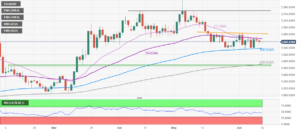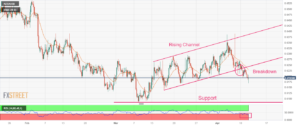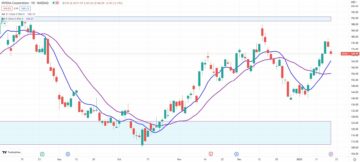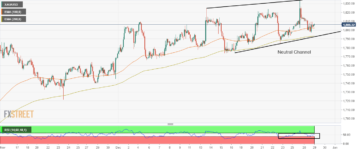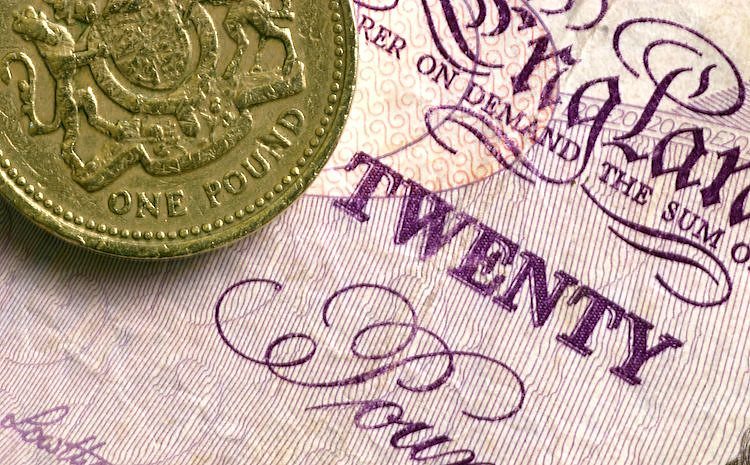
- Pound Sterling gains remain unabated despite the UK’s poor factory data.
- UK firms cut heavily on input costs due to poor demand outlook.
- BoE's Swati Dhingra favored a rate cut if the growth rate dropped more than expectations.
The Pound Sterling (GBP) faces intense selling pressure as the stable United States core Consumer Price Index (CPI) for September month has weakened the risk appetite of the market participants. The outlook for the GBP/USD pair dampened as the Office for National Statistics (ONS) reported that United Kingdom factory data in August contracted for the second time in a row. UK firms operated on lower capacity as they aimed to achieve efficiency by cutting higher inventory backlogs and their respective labor forces due to declining demand.
A slowdown in demand and declining overall output is expected to discomfort Bank of England (BoE) policymakers, who are preparing for November’s interest rate decision. While the BoE's Katherine Mann continued to favor further policy-tightening to bring down inflation to 2% in a timely manner, the central bank's Swati Dhingra supported a rate cut if the growth rate fell beyond expectations.
Daily Digest Market Movers: Pound Sterling appeal fades as market sentiment dampens
- Pound Sterling fails to remain upbeat as the market mood dampens after a nominal decline in the US core inflation as expected. Also, weak UK factory data for August impacted the Pound Sterling.
- Monthly Industrial Production contracted at a higher pace of 0.7%, while investors forecasted a decline by 0.2%. In the same period, the pace of decline in Manufacturing Production was double expectations of 0.4%. In July, the factory data contracted by more than 1%.
- On an annualized basis, Industrial Production landed at 1.3%, below the estimates of 1.7% but higher than the former reading of 1%. The Manufacturing Production at 2.8% remained below expectations and July’s reading of 3.4% and 3.1%, respectively.
- The monthly Gross Domestic Product (GDP) grew by 0.2% as expected. In July, the overall output contracted by 0.6%.
- The factory data has contracted for the second time in a row as UK firms have cut down on inventory and labor due to a poor demand outlook.
- Meanwhile, investors remain mixed about the Bank of England’s interest rate outlook as the UK economy is operating at higher inflation, which is more than three times the desired rate of 2%.
- This week, BoE policymaker Katherine Mann said that central bankers should adopt an aggressive approach toward interest rates. The central bank has to bring down rising inflation expectations along with its priority of bringing down inflation to 2%.
- Contrary to Mann, BoE policymaker Swati Dhingra said the UK economy has already ‘flatlined’ and that almost 25% of the impact of higher interest rates has already been absorbed by the economy. She favored a rate cut sooner rather than later if the growth rate declined beyond expectations.
- The risks of a rebound in inflation are persistent as deepening Middle East tensions would keep the oil market extremely tight through 2024. Also, the expected participation of Iran in the Israel-Hamas conflict could disrupt the supply chain significantly.
- Shortage of energy in the UK economy due to supply chain disruptions could accelerate headline inflation, and UK Prime Minister Rishi Sunak may miss fulfilling his promise of halving inflation to 5.2%.
- The US Dollar Index recovers sharply after the inflation report for September remained mostly in line with estimates. The headline CPI expanded at a higher pace of 0.4% while investors anticipated the growth at 0.3%. Monthly and annual core inflation remained in line with estimates at 0.3% and 4.15 respectively.
- Meanwhile, expectations of one more interest rate increase from the Federal Reserve remained lower as Fed policymakers have turned worried about rising US Treasury yields.
Technical Analysis: Pound Sterling drops sharply to near 1.2250
Pound Sterling faces selling pressure above the crucial resistance of 1.2300 as market sentiment improved. The broader risk outlook remains cautious as participation of more nations in Middle East conflicts could injure the global supply chain significantly. The Cable has climbed above the 20-day Exponential Moving Average (EMA) at 1.2280, which indicates that the short-term trend has turned bullish.
BoE FAQs
The Bank of England (BoE) decides monetary policy for the United Kingdom. Its primary goal is to achieve ‘price stability’, or a steady inflation rate of 2%. Its tool for achieving this is via the adjustment of base lending rates. The BoE sets the rate at which it lends to commercial banks and banks lend to each other, determining the level of interest rates in the economy overall. This also impacts the value of the Pound Sterling (GBP).
When inflation is above the Bank of England’s target it responds by raising interest rates, making it more expensive for people and businesses to access credit. This is positive for the Pound Sterling because higher interest rates make the UK a more attractive place for global investors to park their money. When inflation falls below target, it is a sign economic growth is slowing, and the BoE will consider lowering interest rates to cheapen credit in the hope businesses will borrow to invest in growth-generating projects – a negative for the Pound Sterling.
In extreme situations, the Bank of England can enact a policy called Quantitative Easing (QE). QE is the process by which the BoE substantially increases the flow of credit in a stuck financial system. QE is a last resort policy when lowering interest rates will not achieve the necessary result. The process of QE involves the BoE printing money to buy assets – usually government or AAA-rated corporate bonds – from banks and other financial institutions. QE usually results in a weaker Pound Sterling.
Quantitative tightening (QT) is the reverse of QE, enacted when the economy is strengthening and inflation starts rising. Whilst in QE the Bank of England (BoE) purchases government and corporate bonds from financial institutions to encourage them to lend; in QT, the BoE stops buying more bonds, and stops reinvesting the principal maturing on the bonds it already holds. It is usually positive for the Pound Sterling.
- SEO Powered Content & PR Distribution. Get Amplified Today.
- PlatoData.Network Vertical Generative Ai. Empower Yourself. Access Here.
- PlatoAiStream. Web3 Intelligence. Knowledge Amplified. Access Here.
- PlatoESG. Carbon, CleanTech, Energy, Environment, Solar, Waste Management. Access Here.
- PlatoHealth. Biotech and Clinical Trials Intelligence. Access Here.
- Source: https://www.fxstreet.com/news/pound-sterling-holds-recovery-in-spite-of-weak-uk-factory-data-202310120631
- :has
- :is
- :not
- 1
- 15%
- 2%
- 2024
- 31
- 32
- 33
- 39
- a
- About
- above
- accelerate
- access
- Achieve
- achieving
- Adjustment
- adopt
- After
- aggressive
- aggressive approach
- aimed
- almost
- along
- already
- also
- an
- analysis
- and
- Animate
- annual
- annualized
- Anticipated
- appeal
- approach
- ARE
- AS
- Assets
- At
- attractive
- AUGUST
- average
- Bank
- Bank of England
- Bank of England (BOE)
- bankers
- Banks
- base
- basis
- because
- been
- below
- Beyond
- BoE
- Bonds
- borrow
- bring
- Bringing
- broader
- Bullish
- businesses
- but
- buy
- Buying
- by
- cable
- called
- CAN
- Capacity
- cautious
- central
- Central Bank
- central bankers
- chain
- Climbed
- commercial
- conflict
- conflicts
- Consider
- content
- continued
- Core
- core inflation
- Corporate
- Costs
- could
- CPI
- credit
- crucial
- Cut
- cutting
- data
- decision
- Decline
- Declining
- Demand
- desired
- Despite
- determining
- Digest
- Disrupt
- disruptions
- Dollar
- dollar index
- Domestic
- down
- dropped
- Drops
- due
- each
- easing
- East
- Economic
- Economic growth
- economy
- efficiency
- EMA
- encourage
- ends
- energy
- England
- England’s
- estimates
- expanded
- expectations
- expected
- expensive
- exponential
- exponential moving average
- extreme
- extremely
- faces
- factory
- Fades
- fails
- Falls
- FAQ
- favor
- Fed
- Federal
- financial
- Financial institutions
- financial system
- firms
- flow
- For
- Forces
- Former
- from
- fulfilling
- further
- Gains
- GBP
- GBP/USD
- GDP
- Global
- goal
- Government
- grew
- gross
- Growth
- Halving
- Have
- headline
- heavily
- higher
- his
- holds
- hope
- HTTPS
- if
- Impact
- impacted
- Impacts
- improved
- in
- Increase
- Increases
- index
- indicates
- industrial
- Industrial Production
- inflation
- Inflation expectations
- inflation rate
- input
- institutions
- interest
- INTEREST RATE
- Interest Rates
- inventory
- Invest
- Investors
- involves
- Iran
- IT
- ITS
- jpg
- July
- Keep
- Kingdom
- labor
- Last
- later
- LEND
- lending
- Level
- Line
- lower
- lowering
- make
- Making
- manner
- manufacturing
- Market
- market sentiment
- May..
- Middle
- Middle East
- minister
- miss
- mixed
- module
- Monetary
- Monetary Policy
- money
- Month
- monthly
- mood
- more
- mostly
- Movers
- moving
- moving average
- National
- Nations
- Near
- necessary
- negative
- of
- Office
- Oil
- on
- ONE
- operated
- operating
- or
- Other
- Outlook
- output
- overall
- Pace
- pair
- Park
- participants
- participation
- People
- period
- Place
- plato
- Plato Data Intelligence
- PlatoData
- policy
- policymakers
- poor
- positive
- pound
- pound sterling
- preparing
- pressure
- price
- primary
- Prime
- prime minister
- Principal
- printing
- priority
- process
- Product
- Production
- projects
- promise
- purchases
- QE
- QT
- quantitative
- Quantitative Easing
- raising
- Rate
- Rates
- rather
- Reading
- rebound
- Recovers
- remain
- remained
- report
- Reported
- Resistance
- Resort
- respective
- respectively
- result
- Results
- reverse
- RISHI SUNAK
- rising
- Risk
- risks
- ROW
- s
- Said
- same
- Second
- Selling
- sentiment
- September
- Sets
- she
- short-term
- should
- sign
- significantly
- situations
- Slowdown
- Slowing
- stable
- starts
- States
- statistics
- steady
- sterling
- Stops
- strengthening
- substantially
- supply
- supply chain
- Supported
- system
- Target
- tensions
- than
- that
- The
- the UK
- the United Kingdom
- their
- Them
- they
- this
- three
- Through
- tightening
- time
- timely
- times
- to
- tool
- treasury
- Treasury yields
- Trend
- Turned
- Uk
- UK Prime Minister
- United
- United Kingdom
- United States
- upbeat
- us
- US Core Inflation
- US Dollar
- US Dollar Index
- us inflation
- US Treasury
- US treasury yields
- usually
- value
- via
- was
- week
- when
- which
- while
- Whilst
- will
- with
- worried
- would
- yields
- zephyrnet



